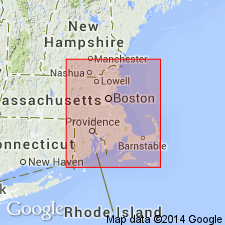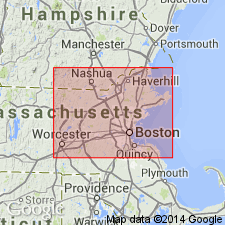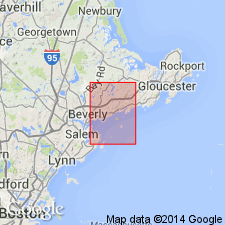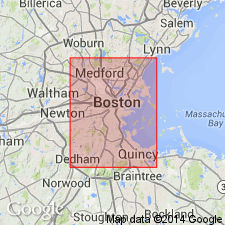
- Usage in publication:
-
- Lynn Volcanic Complex*
- Modifications:
-
- Age modified
- AAPG geologic province:
-
- New England province
Summary:
Lynn Volcanic Complex has been correlated with Late Silurian and Early Devonian(?) Newbury Volcanic Complex and with Proterozoic Z or younger Mattapan Volcanic Complex by other workers. Intruded by alkalic granite of Quincy type, but, according to R.E. Zartman (1980, oral commun.) two groups of alkalic rocks exist in the area, one of Ordovician age (Quincy type) and one of Devonian age (Peabody type). Authors do not know which of the two intrude Lynn at its type locality. Age could range from Proterozoic Z to Devonian; therefore, age is assigned a Proterozoic Z, Silurian, or Early Devonian age.
Source: GNU records (USGS DDS-6; Reston GNULEX).

- Usage in publication:
-
- Lynn Volcanic Complex*
- Modifications:
-
- Overview
- AAPG geologic province:
-
- New England province
Summary:
Used as Lynn Volcanic Complex of Proterozoic Z, Silurian, or Early Devonian age. Consists of rhyolite, agglomerate, and tuff.
Source: GNU records (USGS DDS-6; Reston GNULEX).

- Usage in publication:
-
- Lynn Volcanic Complex
- Modifications:
-
- Revised
- Dominant lithology:
-
- Breccia
- Dacite
- Rhyolite
- Tuff
- AAPG geologic province:
-
- New England province
Summary:
Current thinking designates all felsic volcanics as the Lynn Volcanic Complex with assigned ages ranging from Late Proterozoic to Silurian. Detailed field mapping shows that there are actually two different felsic volcanic units. One of these units is the Lynn Volcanic Complex which has been subdivided into four informal members, three extrusive (Breeds Pond, Baker Hill, and Vinegar Hill members) and one intrusive (subvolcanic member), the other unit is related to the Middlesex Fells Volcanic Complex and the Westboro Formation. The Breeds Pond member is a red, gray and black porphyritic ash fall and tuff. Individual eruption events can be distinguished by upward fining sequences. The Baker Hill member is a red porphyritic ash fall and tuff. It is very homogenous with bedding difficult to determine in the field. The Vinegar Hill member is the most extensive. It is a typical lahar and volcanic breccia containing tuff beds. No bedding is evident in the lahars. The subvolcanic member has a bimodal size distribution of grains that is coarser than the extrusive members.
Source: GNU records (USGS DDS-6; Reston GNULEX).

- Usage in publication:
-
- Lynn Rhyolite*
- Modifications:
-
- Revised
- Age modified
- AAPG geologic province:
-
- New England province
Summary:
The name Lynn Volcanic Complex (as used on MA State Geologic Map, Zen and others, 1983) is changed to Lynn Rhyolite because unit does not fit definition of a formal complex as defined in the 1983 North American Stratigraphic Code. Age is given as Ordovician.
Source: GNU records (USGS DDS-6; Reston GNULEX).

- Usage in publication:
-
- Lynn Volcanic Complex*
- Modifications:
-
- Areal extent
- Age modified
- AAPG geologic province:
-
- New England province
Summary:
Lynn Volcanic Complex is confined to block north of Boston basin between northern border fault and Walden Pond fault. Similar in lithology to Mattapan Volcanic Complex. Both units consist largely of partly porphyritic rhyolite and rhyodacite flows, welded ash-flow tuffs, vitric tuff, lapilli tuff, lithic tuff, flow breccias, breccia pipes, and extrusion domes. Mattapan's rhyolite and rhyodacites are thinner and less varied in composition and texture than Lynn's; volcanic breccias are absent in Lynn. Both units are reported to lie nonconformably on Dedham Granite and unnamed plutonic-volcanic complex of eastern MA. Bell (1976) cites location in Saugus where Lynn overlies both Middlesex Fells Volcanic Complex and diorite intruded into it. Inclusions of Lynn found in Dedham Granite at Pine Hill in Medford (Zarrow, 1978, cited in Naylor, 1981). Lynn has no overlying strata. Both Lynn and Mattapan have been treated as the same age by numerous workers. Billings (1982) accepted Proterozoic Z age of Mattapan (based on U-Th-Pb zircon date of 602+/-3 Ma by Zartman, in Kaye and Zartman, 1980), but questioned reliability of zircon ages from volcanic rocks; he preferred to correlate Lynn rocks with Newbury Volcanic Complex because of Lynn's proximity and lithologic similarity to Newbury. Author feels that proximity argument is not strong because Lynn is geographically and structurally closer to Mattapan rocks. Zarrow (1978, cited in Naylor, 1981) has shown rare-earth element pattern in Lynn rocks to be identical to that in part of Mattapan. Author feels it is reasonable to assume that Lynn and Mattapan are parts of same volcanic complex, and that Lynn in Proterozoic Z in age. However, in view of correlation uncertainties during compilation of MA State bedrock map (Zen and others, 1983) Lynn is shown as Proterozoic Z, Silurian, or Early Devonian [following Goldsmith and others, 1982]. [Chapters A-J in U.S. Geological Survey Professional Paper 1366 are intended as explanations and (or) revisions to 1:250,000-scale MA State bedrock geologic map of Zen and others (1983).]
Source: GNU records (USGS DDS-6; Reston GNULEX).

- Usage in publication:
-
- Lynn Volcanics
- Modifications:
-
- Geochronologic dating
- Age modified
- AAPG geologic province:
-
- New England province
Summary:
New U-Pb ages have been determined by G.R. Dunning as part of ongoing studies of rocks from the Boston-Avalon Terrane. The Lynn Volcanics has yielded a 596+/-3 Ma date, which firmly establishes the Lynn as part of the Late Proterozoic magmatic event in the Boston area. This is the first time the Lynn has actually been dated, though a Precambrian age has been proposed previously because of its similar chemistry to the Dedham Granodiorite.
Source: GNU records (USGS DDS-6; Reston GNULEX).
For more information, please contact Nancy Stamm, Geologic Names Committee Secretary.
Asterisk (*) indicates published by U.S. Geological Survey authors.
"No current usage" (†) implies that a name has been abandoned or has fallen into disuse. Former usage and, if known, replacement name given in parentheses ( ).
Slash (/) indicates name conflicts with nomenclatural guidelines (CSN, 1933; ACSN, 1961, 1970; NACSN, 1983, 2005, 2021). May be explained within brackets ([ ]).

